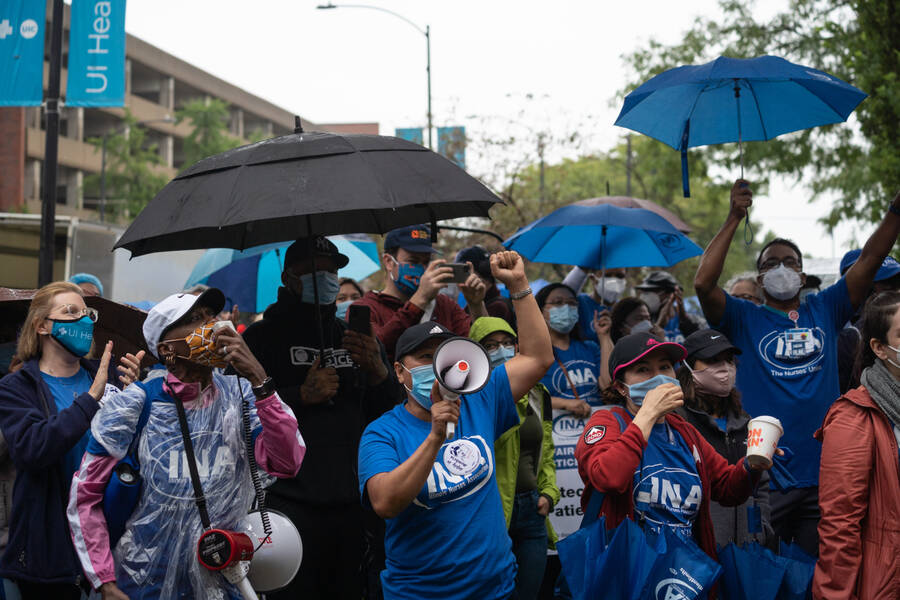
(PHOTO BY MAX HERMAN/NURPHOTO VIA GETTY IMAGES)

Share
This article first appeared at In These Times.
Nearly 5,000 workers at the University of Illinois at Chicago (UIC) are on strike this week in the biggest work stoppage the campus has ever seen. The strikers — who are primarily Black and Latino hospital workers — are fighting for better healthcare, workplace safety, livable wages and racial justice as the Covid-19 pandemic rages on.
The walkout started on September 12 when hundreds of nurses with the Illinois Nurses Association (INA) hit the picket lines, then quickly grew two days later when thousands more clerical, professional, technical and maintenance workers from SEIU Local 73 also went on strike. Both unions have been in the process of negotiating new contracts with the university administration over the past several months.
“We won’t stop until workplace conditions improve, wages are better, safe staffing levels are implemented, PPE [personal protective equipment] is universal, and protections from privatization are in place,” Alicia Uwumarogie, a physical therapist and SEIU Local 73 member, recently explained.
Since the pandemic began, healthcare workers at UIC have been sounding the alarm about inadequate safety measures, including lack of proper PPE and universal testing. According to Joe Iosbaker, a UIC civil service employee with SEIU Local 73, hospital management initially instructed workers not to wear masks, telling them it was “a bad look.”
Approximately 270 UIC healthcare workers have now contracted the novel coronavirus. At least four of them — two INA members and two SEIU Local 73members, along with one worker’s husband — have lost their lives to the virus.
“I personally know of at least four [coworkers] who were on respirators, at least one who flatlined and had to be brought back, and at least four who are now in physical therapy to learn how to walk or talk again,” Iosbaker said.
While publicly praising frontline workers as “heroes,” university administrators remain recalcitrant in contract negotiations, consistently rejecting union proposals meant to improve workplace safety.
“The amount of respect they’ve shown us at the bargaining table is less than zero,” INA co-chief steward Paul Pater recently told WBEZ. “Our members died because they didn’t have the PPE they needed, and the hospital just doesn’t care.”
Instead of negotiating a fair settlement, workers say the administration is busily trying to undermine the strikes. First, the university took INA to court to get an injunction preventing over 500 out of 1,400 nurses from withholding their labor. Then, administrators hired out-of-state strikebreakers to replace striking staff — some of them allegedly from states currently listed on [the City of Chicago’s Emergency Travel Order, which requires people traveling from certain coronavirus hotspot states to self-quarantine for two weeks.
“UIC is bringing in workers from states with higher Covid-19 transmission rates to break a strike from a workforce complaining that management risks worker and patient lives due to inconsistent Covid-19 safety protocol enforcement,” said Dian Palmer, president of SEIU Local 73.
The major contract issue for INA is securing safer nurse-to-patient ratios to ensure quality care, similar to what a proposed state law would do. The university has repeatedly rejected this proposal.
As a candidate in 2018, Illinois Governor J.B. Pritzker told INA members that if elected, he would support safe staffing legislation. As governor, Pritzker appoints the University of Illinois Board of Trustees and serves as an ex-officio trustee himself.
“Governor Pritzker told us if the Safe Patient Limits Act came before his desk, he would sign it,” explained Pater. “Quite frankly, in this proposal, it’s on his desk, as he is the ex-officio of the board of trustees to this university. He needs to keep his promise to us.”
For SEIU Local 73, another major issue in negotiations is making sure all workers are paid at least $15 an hour. Although the Chicago minimum wage is currently $14 per hour, UIC pays many of its predominantly Black and Latino building service workers only $11 to $12.
The university can get away with this because, as a state employer, it is exempt from the city’s minimum wage law — a caveat that allows UIC to also pay undergraduate student workers a subminimum wage. Meanwhile, University of Illinois president Timothy Killeen was awarded a $235,000 raise earlier this year, after having received bonuses between 2016 and 2018totaling $300,000 and also being provided with a mansion.
“I shouldn’t have to struggle from paycheck to paycheck when I’m working every day,” said building service worker Sharon Geddis. “President Killeen doesn’t have to struggle, why should I?”
The INA and SEIU Local 73 strikes are only the latest example of worker unrest at the University of Illinois. Last year, 1,500 graduate workers at UIC waged a nearly three-week strike before winning a new contract, and UIC faculty came within a hair’s breadth of also striking. At the Urbana-Champaign campus downstate, graduate workers led a successful two-week strike in 2018, and non-tenure-track faculty won a first contract in 2016 after a two-day strike.
The recent uptick in worker militancy at the university is partly a response to the administration’s union-busting efforts in the wake of the Supreme Court’s anti-labor Janus decision — which has put all public sector unions on the defensive. Combined with the hazardous working conditions related to the pandemic and the administration’s unwillingness to compromise at the bargaining table, it’s little wonder why UIC is now experiencing the biggest strike in its history.
As Palmer put it, “UIC workers are not only fighting for their livelihoods, but for their lives, the safety of their families, and the communities being served.”

